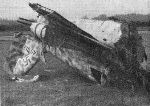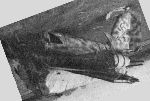
|
Mano Ziegler's book 'Raketenjäger Me 163 / Rocket Fighter' contains a dramatic description of the misfortune of JG400 on 7 October 1944. No less then four Komets were lost, killing two pilots and injuring another. One of the deaths was Manfred Eisenmann, flying Komet 440013.
According to Ziegler, five Komet stood on alert on the runway end, fully tanked. Then the wind suddenly changed direction, but there was no time to move the Komets to the other runway end. Eisenmann and Husser started with tailwind, to intercept a large bomber formation. Three Komets were left waiting on the (wrong) runway end, ready to be launched, with Glogner, Strasnicki and Rolly waiting in the cockpits. Some time later, Eisenmann and Husser returned from a fruitless intercept. Wisely they chose to land with headwind, on the grass next to the runway as usual. The three Komets were still parked on the runway, and their crews observed the Komet coming in from the other end.
Husser was much lower than Eisenmann, probably too low to make another circuit, but too high for a proper landing. He pushed his Komet on the grass, bounced up at high speed, and touched down again close to the end of the runway, near the three parked Komets. Of course he had way too much speed, and ran off the airfield, into farmland, and then into low bushes. His Komet flipped over, but did not explode. Husser was trapped in the cockpit but rescued quickly. He suffered a dislocated arm, a broken nose, and his head was bleeding profusely. The Komet, 440165, was 75% damaged.
Then Eisenmann came in to land. He too came in too high, but he side-slipped it strongly to create drag, and also lost height quickly. He touched down, bounced up, heading for the three Komets. He then rolled his Komet 180 degrees on its back, then another 90 degrees, and then hit the ground with his right wingtip. The Komet started cartwheeling, still heading towards the fully tanked three Komets. Glogner and Rolly quickly jumped out of their Komets, but at the same time Eisenmann flew by, and came to a halt some 150 meters behind them. Eisenmann was ejected from the cockpit with his seat, but he was dead.
The unique photo below, kindly supplied by Gilbert Haentjens from Belgium, shows the remains of Eisenmann's Komet. The cockpit section and the wings are severely crushed, but the tail is remarkably intact. This agrees pretty much with the cartwheeling motion that Ziegler describes.

|
This Komet with Werknummer 440013 is one from the first batch built by Klemm. It is roughly the 80th Komet built. The wreckage unfortunately does not reveal many airframe and armament details. One strange part are the two dark beams projecting from the tail. The cockpit is completely crushed. The left wing is missing large parts of its structure. Part of the massive front spar seems to be visible, as well as a piece of skin, the flap well, and a completely bent trim flap. The rest is missing. The wreckage shows no signs of an explosion, which would have blown up the center fuselage. This type of landing explosion is often reported in more popular books, but I doubt whether it occured on a regular basis.
This Komet has a mottled fuselage, like many other early Komets. No code is visible behind the fuselage iron cross, but this area is largely obscured by parts of the wrecked wing. The Werknummer is clearly visible on the tail, in the usual, or perhaps slightly high location. The WNr execution is rather sloppy. Typical is the slightly larger space between '440' and '013'. The first digit seems to be placed lower than the other digits, and the first '0' is smaller than the other digits, including the second '0'. T-Stoff markings can be seen near the filler opening behind the cockpit and near the overflow tube behind the skid. The rotated photo below is an attempt to show this Komet in a more natural attitude.

|